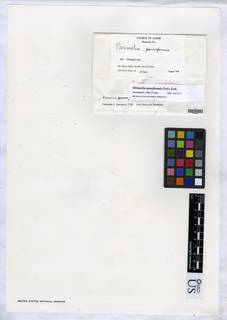
Consortium of Lichen Herbaria
- building a Global Consortium of Bryophytes and Lichens as keystones of cryptobiotic communities -
- Home
- Search
- Images
- Species Checklists
- US States: O-Z >
- US National Parks
- Central America
- South America
- US National Parks
- Southern Subpolar Region
|
|
|
|
Family: Parmeliaceae
[Imbricaria pannariiformis (Nyl.) Arnold, moreMelanelia panniformis (Nyl.) Essl., Melanelia panniformis f. panniformis (Nyl.) Essl., Melanelia panniformis f. pruinosa (Räsänen) S.Y. Kondr., Melanelia panniformis f. pulvinata (Laurer) S.Y. Kondr., Parmelia olivacea f. panniformis (Nyl.) Th. Fr., Parmelia olivacea var. panniformis Nyl., Parmelia panniformis (Nyl.) Vain., Parmelia panniformis f. panniformis (Nyl.) Vain., Parmelia panniformis f. pruinosa Räsänen, Parmelia panniformis f. sorediifera H. Magn., Parmelia panniformis var. panniformis (Nyl.) Vain., Parmelia panniformis var. pulvinata Hillmann, Parmelia prolixa f. panniformis Nyl.] |
Nash, T.H., Ryan, B.D., Gries, C., Bungartz, F., (eds.) 2002. Lichen Flora of the Greater Sonoran Desert Region. Vol 1. Thallus: adnate to loosely adnate, appressed to pulvinate, usually ± panniform, foliose, up to 7 (-10) cm diam., but at times coalescing into larger patches, lobate lobes: short and rounded to more often somewhat elongate, discrete to ± imbricate, (0.3-) 0.5-1 (-1.5) mm broad, mostly flat upper surface: olive-brown to reddish-brown or dark brown, smooth to weakly pitted at the periphery, inward essentially the same but usually hidden by numerous small and imbricate lobules; dull or somewhat shiny, occasionally lightly pruinose; without pseudocyphellae on the primary lobes, but occasionally present (but obscure) near the ends of the lobules; without true isidia, the marginal primary lobes with small ± spherical to clavate isidioid lobules, inward these soon developing into dorsiventral lobules lower surface: black, paler at the periphery; smooth to irregularly wrinkled or plicate, dull or slightly shiny; moderately to somewhat sparsely rhizinate, the rhizines concolorous with the lower surface Apothecia: uncommon, up to 3 mm diam., sessile, flat to somewhat concave, the margin at first entire, very soon papillate to tuberculate or becoming lobulate asci: clavate, 8-spored ascospores: ellipsoid, 9-11.5 x 4.5-7 µm Pycnidia: common, immersed conidia: ± cylindrical to weakly fusiform or acerose, (4-) 5-7 x c. 1 µm, Spot tests: cortex K-, C-, KC-, P-, HNO3-; medulla K-, C-, KC- or rarely KC+ faint dingy rose, P- Secondary metabolites: perlatolic and stenosporic acids (both major), occasionally with trace unknowns. Substrate: rocks World distribution: ± circumpolar in the Northern Hemisphere, south in North America to Arizona and Baja California in the West and to New York in the East, northern and central Europe and possibly throughout Siberia, South America Sonoran distribution: known from only two localities, one in the Chiricahua Moutains of Arizona, and the other in Baja California. Notes: Within the area of study, the only related species is M. disjuncta, which is easily distinguished by the presence of soralia and of obscure submarginal pseudocyphellae on the lobes. The collection of M. panniformis from Arizona is typical, although not a very large specimen. The specimen from Baja California is very sparse and poorly developed, and has only a few small lobules beginning to develop. Nevertheless, the morphology is otherwise characteristic, and its identity was confirmed by TLC. |
Powered by Symbiota


















































